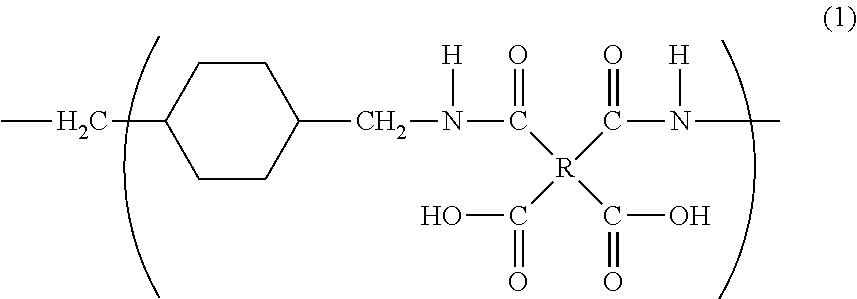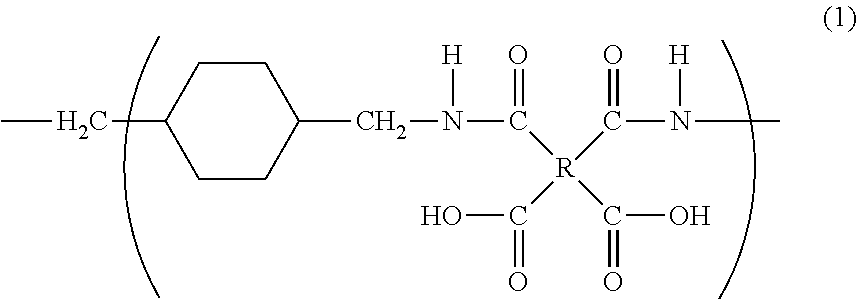Polyamic acid and polyimide, processes for the production of same, compositons containing same, and uses thereof
- Summary
- Abstract
- Description
- Claims
- Application Information
AI Technical Summary
Benefits of technology
Problems solved by technology
Method used
Image
Examples
example 1
[0131]15.7 g (0.110 mol) of 1,4-bis(aminomethyl)cyclohexane (14BAC) and as an organic solvent 192 g of N,N-dimethylacetamide (DMAc) are charged into a 300 mL five-neck separable flask equipped with a thermometer, a stirrer, a nitrogen inlet and a dropping funnel, and stirred. The cis / trans ratio of 1,4-bis(aminomethyl)cyclohexane is 9 / 91.
[0132]The flask is charged with 32.4 g (0.110 mol) of 3,3′,4,4′-biphenyltetracarboxylic dianhydride (BPDA) and placed in a 120° C. oil bath for 5 minutes. Salting out occurs about 3 minutes after addition of BPDA, immediately after which the salt is observed to be re-dissolved in the solvent. After removing the oil bath, the solution is stirred for a further 18 hours at room temperature to yield a solution containing a polyamic acid (polyimide precursor polymer), i.e., a polyimide precursor polymer varnish. The resultant polyamic acid has an intrinsic logarithmic viscosity of 0.94 dl / g (35° C., 0.5 g / dl).
[0133]The polyamic acid solution is spread ov...
example 2
[0134]118 g (0.400 mol) of 3,3′,4,4′-biphenyltetracarboxylic dianhydride (BPDA) and as an organic solvent 290 g of N,N-dimethylacetamide (DMAc) are charged into a 1 L five-neck separable flask equipped with a thermometer, a stirrer, a nitrogen inlet and a dropping funne, and stirred in a 0° C. ice bath to produce a slurry-like liquid. 56.9 g (0.400 mol) of 1,4-bis(aminomethyl)cyclohexane (14BAC) and 117 g of N,N-dimethylacetamide (DMAc) loaded in the dropping funnel are added dropwise to the solution over 2 hours. The cis / trans ratio of 1,4-bis(aminomethyl)cyclohexane is 9 / 91.
[0135]After addition, the solution is stirred for a further 16 hours at room temperature to yield a polyimide precursor polymer varnish. The resultant polyamic acid has a logarithmic viscosity of 0.73 dL / g (35° C., 0.5 g / dl). A polyimide film is prepared as in Example 1. Test results are shown in Table 1.
example 6
[0138]A polyamic acid is prepared as in Example 1 except that 3,3′,4,4′-benzophenonetetracarboxylic dianhydride (BTDA) is used instead of 3,3′,4,4′-biphenyltetracarboxylic dianhydride (BPDA).
PUM
| Property | Measurement | Unit |
|---|---|---|
| Temperature | aaaaa | aaaaa |
| Fraction | aaaaa | aaaaa |
| Fraction | aaaaa | aaaaa |
Abstract
Description
Claims
Application Information
 Login to View More
Login to View More - Generate Ideas
- Intellectual Property
- Life Sciences
- Materials
- Tech Scout
- Unparalleled Data Quality
- Higher Quality Content
- 60% Fewer Hallucinations
Browse by: Latest US Patents, China's latest patents, Technical Efficacy Thesaurus, Application Domain, Technology Topic, Popular Technical Reports.
© 2025 PatSnap. All rights reserved.Legal|Privacy policy|Modern Slavery Act Transparency Statement|Sitemap|About US| Contact US: help@patsnap.com



